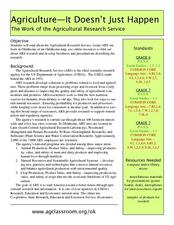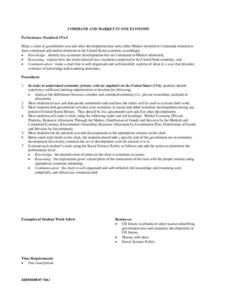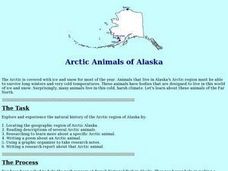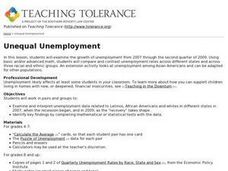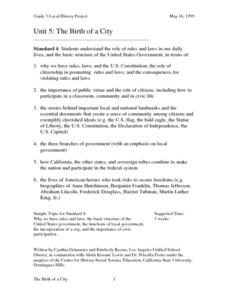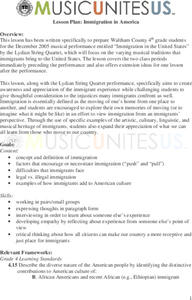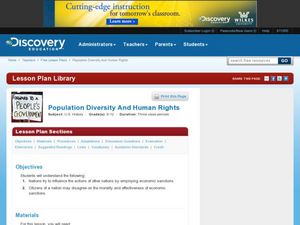Curated OER
Native Versus Exotic
Students investigate the presence of exotic and natural species in the ecosystem. They define the differences between exotic and native while looking at one specific ecosystem in Maryland. They write how the exotic species are considered...
Curated OER
Space Age Technology Comes to Earth
Students explore jobs related to agriculture. In this technology/agriculture lesson plan, students recognize the importance of natural resources and agriculture on the use of Range Rambler software. Students complete an experiment...
Curated OER
No Impact Project: Water
Students use the "No Impact Project" to analyze the consumption of water. In this water consumption lesson, students discuss the pros and cons of tap water or bottled water. Students read about chemicals in water and watch a video clip...
Curated OER
Agriculture - It Doesn't Just Happen
Sixth graders examine the role of the US Department of Agriculture. In this United States Agriculture lesson plan, 6th graders create maps with sites and specialty areas. Students create a presentation on the topic they were given to...
Curated OER
Command and Market in One Economy
Students organize governmental acts on a chart as either a Market or Command economy. In groups, they note the characteristics of each type of economy and identify their differences. They also explain any item that is related to the...
Curated OER
The Meat-Packing Industry in Chicago During the Progressive Era
Students examine maps showing the hog and corn distribution of the United States. In groups, they research the reasons why Chicago became the natural hub for meat-packing processing in the United States. They examine changes in...
Curated OER
Wartime and the Bill of Rights: The Korematsu Case
Learners examine the balance between civil liberties and protection. In this national security lesson, students explore the Korematsu case which references the Japanese internment camps of World War II. Learners draw comparisons between...
Curated OER
Arctic Animals of Alaska
Students explore the natural history of arctic Alaska through lecture and discussion. They write poems and complete research papers about Arctic animals.
Curated OER
Wetlands: Pave or Save?
Students discuss the characteristics of wetlands and how to make them more productive. Using a map, they locate the major wetlands in the United States and color them using a key. They read an article and in groups answer discussion...
Curated OER
The Desert Alphabet Book
Learners use a book to discover an interesting fact from the desert using each letter of the alphabet. Using a United States map, they identify the meanings of symbols and locate deserts within the U.S. In groups, they participate in...
Curated OER
Unequal Unemployment
Young scholars examine unemployment in the United States. In this statistics lesson, students examine data and primary sources regarding unemployment in the United States.
Curated OER
The Birth of a City
Third graders understand the role of rules and laws in our daily lives. They research the basic structure of the United States government. They participate in a simulated City Council meeting.
Curated OER
Nick News Lesson
Students understand the causes of the devastation in the aftermath of Hurricane Katrina in the Gulf Coast States. They perceive the ways that children in the region are coping with the aftermath of Hurricane Katrina.
Curated OER
Places Of Power
Fourth graders investigate the Native American religious concept of Sacred Landscapes. The use of natural resources and religious rites is researched using a variety of sources. They discuss the importance of geographical places in the...
Curated OER
Immigration in America
Fourth graders examine the musical traditions that immigrants bring to the United States. They discuss the concept of home, complete the "My Home" worksheet, participate in a class discussion, and write a letter to a fourth grade...
Curated OER
Imperialism and Expansion: Part 1
Young scholars explore the era of imperialism and expansion of the United States. In this American history lesson plan, students play a game regarding the U.S. attempts to expand the nation in the late 1800s and early 1900s.
Curated OER
Population Diversity And Human Rights
Students explore the concept of economic sanctions. In this population diversity and human rights lesson, students examine how the United States uses economic sanctions to support or prohibit international activities. Students present...
Curated OER
Why Is Evolution Controversial?
Students explore why evolution has always been a controversial topic. They use scientific process to determine patterns and to critically analyze alternative explanations for natural phenomena.
Curated OER
Colors of Wildlife
Students observe wildlife animals. In this wildlife lesson, students cut out three different animals from a wildlife magazine. Then they compare the animals, verbally stating their similarities and differences.
Curated OER
Water Pressure - Disparity of Resources
High schoolers examine the disparity of resources between developing and industrialized nations, and research the problem of water availability as world populations increase and natural resources are stressed.
Curated OER
Japan/Kimonos
Second graders identify the kimono as a traditional Japanese clothing. They explain the importance of nature in Japanese traditional crafts. They create and design their own kimono.
Curated OER
Wild Animal Investigation - Habitat Diorama
Students research wild animals in cooperative groups and use their information to construct habitat dioramas. They demonstrate competence in using different information sources, including those of a technical nature, to accomplish...
Curated OER
Crossing the Oregon Trail
Students become familiar with the sacrifices that the migrants endured crossing the plains to the west. They experience some of the problem solving that the pioneers faced and pay the natural consequences of their choices.
Curated OER
Mercury in the Environment
Learners develop abilities necessary to do scientific inquiry. They develop an understanding of chemical reactions, structures and properties of matter. They develop decision-making skills in natural and human-induced hazards.



